Chuuk Lagoon — World’s biggest naval graveyard
Way over on the western side of the Pacific Ocean is a beautiful, tropical atoll that was the site of one of the most one-sided and decisive battles of World War II. Here, at Chuuk Lagoon — also known as Truk Lagoon, the Gibraltar of the Pacific — the US Navy did to the Japanese fleet what the Japanese did to the American fleet at Pearl Harbor.
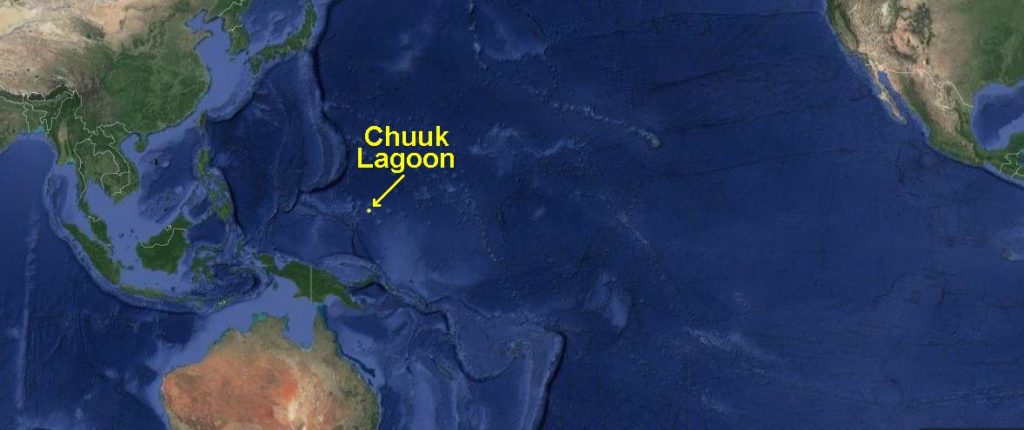
Operation Hailstone, 17–18 February 1944, was a massive US Navy air and surface attack on Truk Lagoon. In two days, 500 carrier-based American Hellcats, Avengers and Dauntless dive bombers sank or damaged more than 50 Japanese ships, destroyed more than 250 Japanese warplanes, and killed almost 5000 Japanese soldiers. For a dramatic 9-minute newsreel documenting this attack, click the video below.
Truk lagoon is shallow: 30-60 meters deep. The water temperature is comfortable: 28° C (83° F). The outer barrier reef blocks the big swells of the Pacific Ocean and makes for calm water inside the lagoon. There are no major industries on Chuuk’s islands, so the water is clear and pollution free.
After sitting on the bottom of the lagoon for more than 75 years, Truk’s sunken ships and airplanes are encrusted in colorful corals. These wrecks are home to millions of tropical fish. They are a beautiful, fascinating and eerie place to go scuba diving.
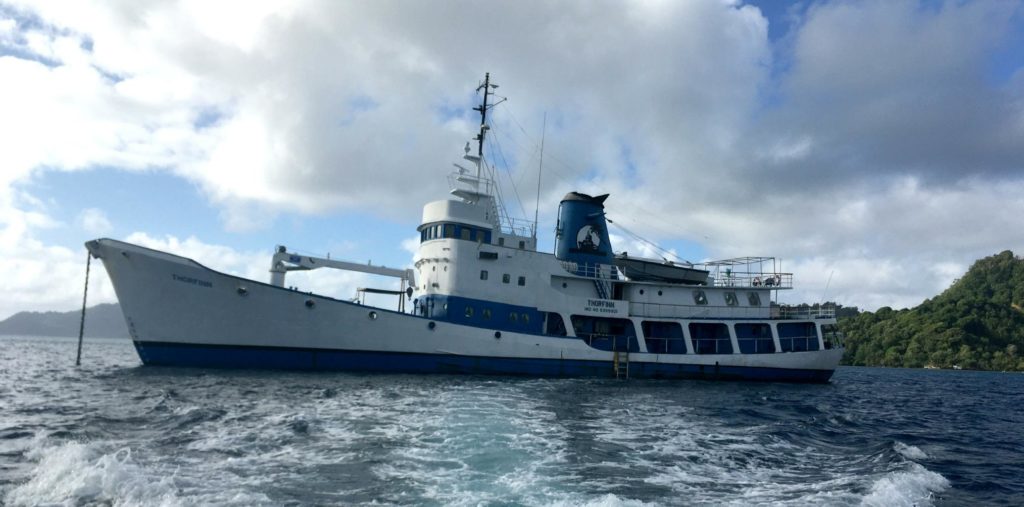
To see these sunken ghost ships, I signed up for a week of scuba diving aboard the S.S.Thorfinn, shown above. The Thorfinn claims to be the oldest and biggest liveaboard in the world. Built in 1952 and 58 meters long, this might be true. Captain Lance (82) has been operating this dive boat in Truk Lagoon for more than 40 years and knows every wreck inside and out. Every day, before each dive, he recounted how each ship was sunk, what relics would be seen aboard, and how many Japanese sailors died.
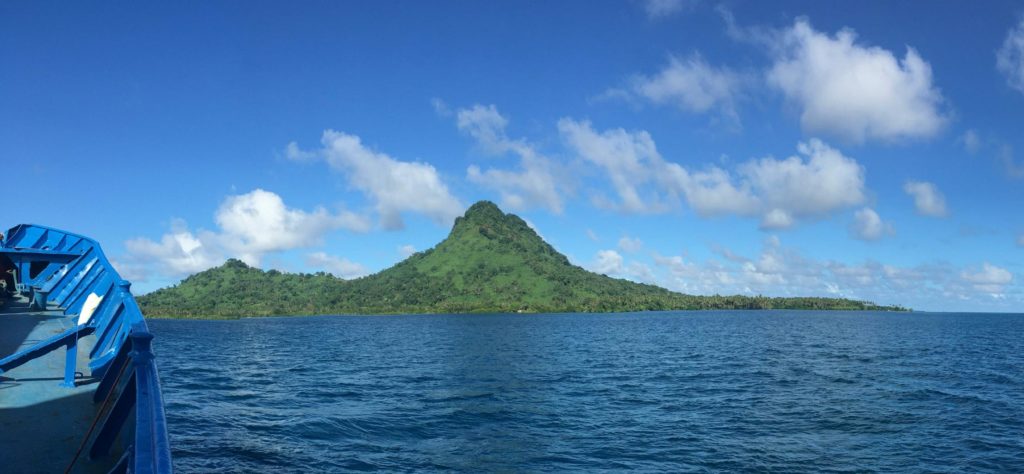
Truk Lagoon is about 30 km in diameter. Most of the Japanese ships were sunk at anchor in the straits between the inner islands. Consequently, the floor of the lagoon is littered with wreckage. One doesn’t have to go far to find a sunken ship. Under the water in the photo above, there are about a dozen large ships. The largest is the Heian Maru, 163 meters (536 feet) long.

Here’s our dive crew, which consisted of two local guides and three paying customers. Normally, there would be several more divers for a big dive program like this. Because of the coronavirus travel ban imposed by the FSM (Federated States of Micronesia), only three of us were allowed to fly into Chuuk last week. It was a rare opportunity to have an entire dive boat to ourselves.
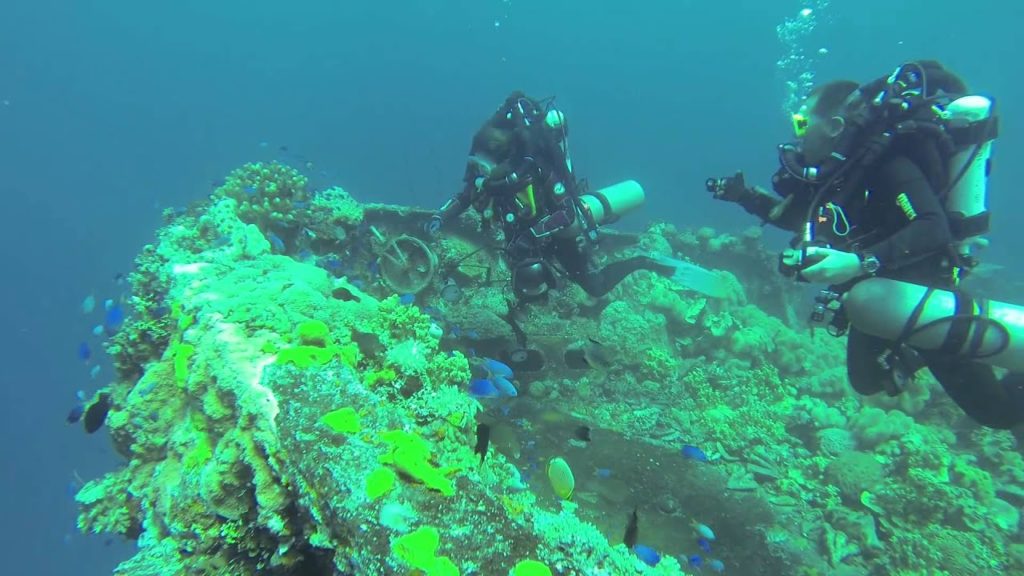
I don’t carry an underwater camera. When I’m down below, I’m usually so fascinated by what I’m seeing that I don’t have time to stop to take a picture. There are plenty of other divers who are excellent photographers. If you’d like to see what I saw on the floor of the Truk Lagoon, please click on the photo above.
In seven days, I did 28 dives for a total of 17 hours and 15 minutes under water. (With many repetitive deep dives, it’s important to keep detailed logs so as not to exceed safe decompression limits.) My deepest dive was 51 meters (167 feet). That’s a long way under water. Even on a sunny day, it gets dark down there.
With dozens of big shipwrecks in clear, warm, shallow water, Truk Lagoon is the world’s premier wreck diving location. Diving the Truk Lagoon was an amazing and unforgettable experience. I hated history in school. But learning history first hand by visiting the sites where events actually happened makes history exciting. With 28 wreck dives, I also learned how to safely enter and exit a rusty metal hulk that’s full of silt and live ammunition!

In addition to learning how to wreck dive, I’m learning about the FSM (Federated States of Micronesia). This country consists of 607 small islands sprinkled across 2700 kilometers of the Pacific Ocean. The FSM is divided politically and culturally into four states. So far, I’ve been to two of them: Yap (the island of stone money) and Chuuk (the world’s largest naval graveyard). Yap and Chuuk have different languages and customs. Even the people look different. I still have two more states to explore. My FSM visa is good for 30 days, so I’ll have to keep moving to see it all.
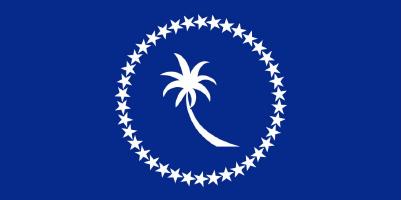

How nice, while working early in the morning, to get a bit of an escape. Thank you for that opportunity!
Super great account and pics, Nick!
Cool Stuff! Looks like you are having a blast. 167′ feet deep, yikes. Makes my ears hurt just thinking about it. Thanks for the history lesson and a little fun reading and watching. Keith
That is some incredible video footage, with narration that isn’t that much more hyperbolic than one hears/sees today. Ironic that the Japanese would repeat a critical mistake of the Americans at Pearl Harbor — of concentrating its forces in a vulnerable position. At least, so it seems from this video. This battle doesn’t have the same public awareness of others in the Pacific
I remember becoming enamored with Truk Lagoon after watching weekend re-airings of Jacques Cousteau show from 1969. As a young kid, history junkie, living on a beach in Ft. Lauderdale with time to daydream…I dreamed of diving there. Years later, I got my PADI card and enjoyed a wreck dive on my first post training dive, but have never made it to Truk. Thank you for sharing and I will blame you for why I am going to make Leah watch a 51 year old TV show on diving Truk. 😉
Been wondering where in the world you are and if perhaps you were quartined, it’s good to hear you are well. Maybe that’s the sure way to escape the virus; stay underwater! Unfortunately, our lake isn’t thawed yet. Stay well.
Simply Awesome!